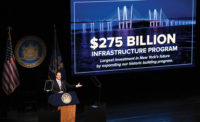
India plans to boost infrastructure spending to $1.2 trillion as part of the country's 12th Five-Year Plan for the years 2012-2017, with the amount set to come from private investment rising to 50% from, during the last plan, 30%. Finance Minister Pranab Mukherjee noted the figures on March 16, when he announced the country's 2012-2013 budget.
To make private investment more attractive, the government is increasing the availability of tax-free bonds and allowing more infrastructure sectors—such as oil and gas, flood control and telecommunications—to qualify for project seed money to pay for the early stages of work.
The government aims to double the amount of available tax-free bonds for infrastructure to $12 billion a year since the last plan, said Mukherjee, including $2 billion earmarked annually for highway projects. For this year and next year, he set a target of constructing 8,800 kilometers of roads.
The country's ambitious transportation expansion plans include building the 1,483-km Delhi-Mumbai Industrial Corridor, an estimated $90-billion development program that is set to feature highways, a high-speed freight rail line, three ports, six airports and a 4,000-MW powerplant. Major funding is set to come from Japan and private investors.
Further, the Urban Development Ministry will have significant new funding to build and extend urban rail networks in Delhi, Bangalore, Kolkata, Chennai, Mumbai, Jaipur and Kochi.
Mukherjee said additional energy, communications, water and wastewater infrastructure projects “will be considered for approval in the next eight years.”
With the government's proposal to loosen rules for so-called "external commercial borrowings" for power, aviation, low-cost housing and road investments, corporations looking to expand now will have easier access to capital from overseas lending and credit sources.
Industry observers hope the proposed cash boost and incentives for private investment will overcome longtime barriers to much-needed infrastructure development in India. "While change will ultimately take place in mind-sets, it is moving too slowly,” Ramakant Jha, director of the Gujarat International Finance Tec-City, a planned high-tech commericial development in Gujarat state, told ENR. "Targets are not met because of lack of proper institutional mechanisms for implementation."
Vishwas Udgirkar, senior director in India for financial consultant Deloitte LLC, says, "Allowing [companies] to raise money through tax-free bonds shows the government's commitment to provide required financial support."
However, in a new report analyzing obstacles to private participation in Indian infrastructure projects, Standard & Poor's notes hurdles such as a planned 340% hike in airport taxes expected for the privately owned Delhi airport.
"The potential large increase in tariffs at Delhi airport emphasizes the need for a detailed public-private participation policy and planning at all levels of the government," says S&P credit analyst Rajiv Vishwanathan.
"In our view, higher tariffs could negatively affect the credit quality and resilience of some low-cost airlines operating out of Delhi," Vishwanathan said. "Large international full-service airlines may reduce the number of flights to the city, but we don't expect them to cease operations to Delhi or move their hubs to lower-cost airports."
Vishwanathan also pointed to a need for "standardization of procurement processes, transparency in bidding, proper risk allocation among the different parties in a project and adequate project preparation and feasibility studies that can make infrastructure projects more viable." He added, "Having these factors can go a long way toward building confidence in a project and attracting private funding."



Post a comment to this article
Report Abusive Comment